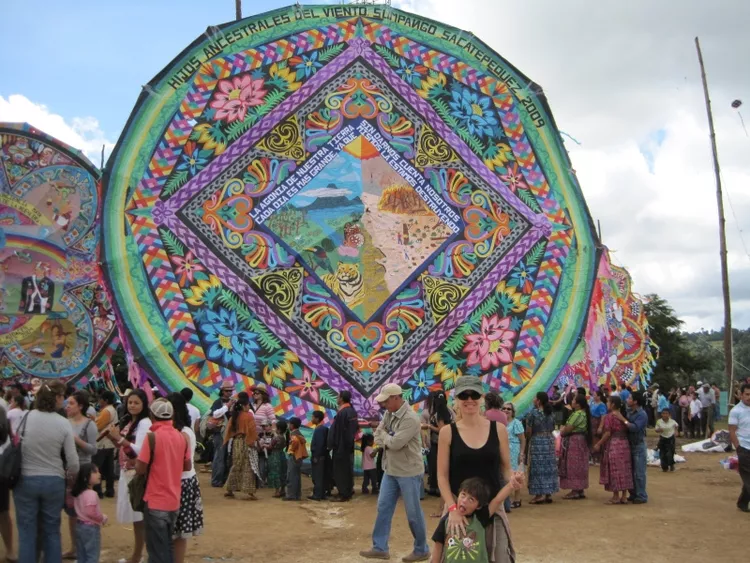Summary
Meta Description: Discover the vibrant traditions of the Day of the Dead in Guatemala, including cemetery visits, the Giant Kite Festival, and traditional foods, while honoring the beloved departed.
The Day of the Dead Celebration
The Day of the Dead (El Dia de los Muertos) is a vibrant celebration taking place each year on November 1st and 2nd throughout Latin America, especially in Guatemala. This festive occasion allows Guatemalans to remember their deceased loved ones and celebrate their memory. It is believed that during this time, the souls of the departed return to Earth to reconnect with their families.
Numerous traditions and legends surround this holiday, encompassing various activities to commemorate relatives. From visiting cemeteries to enjoying traditional foods like fiambre, attending kite festivals, and setting up altars known as ofrendas, there are countless ways to honor the Day of the Dead in Guatemala.
However, the most remarkable locations to experience this spirit-filled holiday are the highland villages of Santiago Sacatepéquez and Sumpango. Both towns, just a 30-minute drive from Guatemala City, hold a spectacular Kite Festival each year.
Visiting the Cemetery: Honoring the Dead
One of the most cherished traditions among local Guatemalans during the Day of the Dead is visiting the graves of their loved ones. Some families choose to honor their deceased by placing flowers on mausoleums and offering prayers for their souls, while others bring food, don their best attire, and spend the day and night at the cemetery, celebrating the memories of those who have passed.
Tradition dictates that a plate of food is served on the ofrenda for the deceased, while the remaining family members eat and celebrate together. As night falls, cemeteries transform into lively gatherings where relatives and friends of the deceased partake in music, dancing, and feasting, creating a festive atmosphere.
When it’s time to head home, locals are cautious about how they depart at night. It is believed that spirits can appear as moths, potentially getting trapped in open glasses of water or suffering from burns in lit candles. Therefore, families ensure that all flames are extinguished, and any standing water is emptied before leaving. If a moth dies during the celebrations, it signifies that the spirit will be trapped and unable to return the following year.
The Giant Kite Festival
Another significant tradition observed during the Day of the Dead is the Kite Festival. Large gatherings occur in various parts of the country, where people showcase their kites, letting them soar as a symbolic tribute to the deceased.
What signifies the Kite Festival in Guatemala is the impressive size of the kites. Enthusiasts dedicate an entire year to crafting and designing kites, many exceeding 40 feet in height. This stunning display enlivens the skies above cemeteries nationwide.
While several Kite Festivals take place across Guatemala, the most notable occurs in Sumpango, where visitors can also explore numerous vendors offering local culinary delights, handcrafted goods, and smaller kites for participants to fly during the festivities.
Traditional Food
As with many festivals worldwide, the Day of the Dead in Guatemala is closely associated with unique culinary offerings that are prepared exclusively for this occasion.
A significant portion of Guatemala’s traditional dishes consists of variations of stews, rich in spices. On the Day of the Dead, however, Guatemalans indulge in fiambre, a hearty and distinctly flavorful dish. This creation is composed of various vegetables, meats, and, at times, different types of cheese and a tangy dressing.
Other beloved traditional foods prepared during this festive period include tamales, ayote en dulce (sweet potato in milk), and pan de muertos, a sweet bread specifically baked for the holiday. Across Latin America, sugar skull candies and baked goods also take center stage during this time.
Celebrating the Elements
Throughout these traditions, Guatemalans ensure that they pay tribute to the four essential elements: earth, wind, water, and fire.
At cemeteries and on their ofrendas, families burn candles to guide the deceased back to the realm of the living, symbolizing fire. Water and earth are represented through the offerings of food and drink, including fiambre and tamales. Additionally, cempazuchitl (marigolds), often used to adorn graves, embody the earth element. In contrast, Guatemalans utilize papel picado—colorful cut-out tissue paper used in both kite festivals and home decorations—to represent wind and air.





